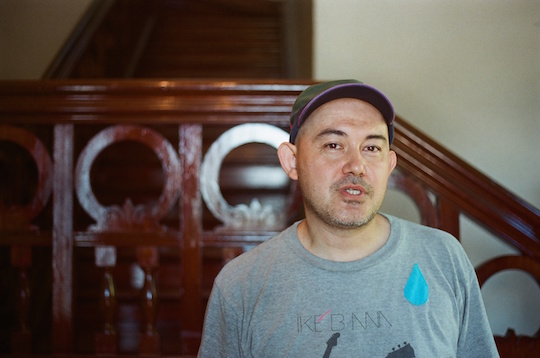 Photo: Ari Morimoto at Guggenheim House
Photo: Ari Morimoto at Guggenheim House
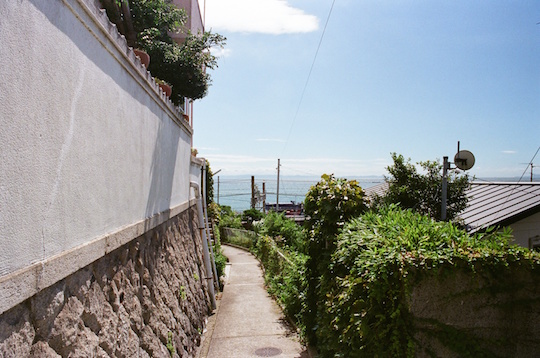 Guggenheim House, a unique Western-style residence that remains in Shioya
Guggenheim House, a unique Western-style residence that remains in Shioya
Shioya is located about 20 minutes by train from Sannomiya, a downtown area of Kobe. Since the area did not suffer major damage from the Great Hanshin-Awaji Earthquake and is very close to the mountains and sea, there are many old stores in front of the station without any major development. Having long been loved by foreign people, unique Western-style houses still remain in the town. Among these, Guggenheim House is particularly eye-catching.
Ari Morimoto is well known as a musician and as the manager of Guggenheim House by people in the Kansai region, especially among those who love music.
When he heard that the Great Hanshin-Awaji Earthquake had struck, he was living in Belgium studying modern art. Although he realized from the TV news that a terrible disaster had happened, he stayed in Belgium as a student for a while, knowing his family and friends were safe. When he returned to Japan during the summer vacation, visiting Kobe and other places, he began to think more deeply about Japan.
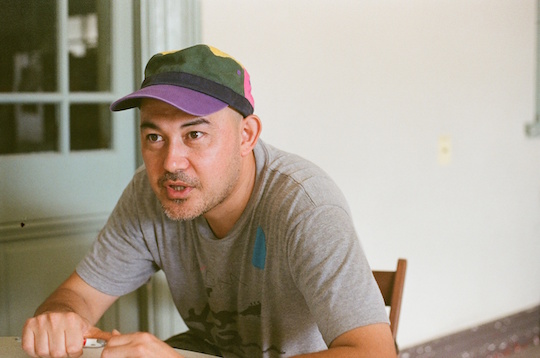 Seeing recovery activities from Shioya
Seeing recovery activities from Shioya
The year 1995 was a memorable one for me, because of the sarin gas attack on the Tokyo subway system, the 50th anniversary of the end of the war, and many other events. About six months after the earthquake, Swiss filmmakers visited Japan to produce a documentary film. I traveled around Japan with them during the summer vacation.
In Kobe, they interviewed affected people and took a video of the many temporary houses near the roller coaster in Kobe’s Portopia Land, which was already in operation at that time. Mr. Morimoto says that the scene was very memorable due to the strong contrast. The team also visited Hiroshima and Nagasaki to meet survivors of the atomic bombings, as well as Unzen and Minamata.
I was very surprised to see that many places in Kobe had already been bulldozed, since, in Europe, I saw a lot of remains from wars and disasters that were left as they were.
Returning to Japan after graduating from university in Belgium, Mr. Morimoto questioned the methods of Japan’s disaster recovery system, seeing how the city of Kobe had changed.
Most of the good old shopping streets with small stores, row houses, and old buildings in Kobe have been turned into tall modern buildings under the pretext of reconstruction. Simply creating big structures and drawing lines on a map breaks the continuity of history and memories. I don’t think an old woman, for example, who used to live in a wooden apartment would be very happy moving to a high-rise apartment building.
By removing old things and building new structures, Kobe has rapidly lost many of its small towns, which used to be very vibrant. I believe Shioya will remain as a target for comparison with such towns. Since Shioya didn’t suffer any major damage from the earthquake, the town hasn’t changed that much from the old days.
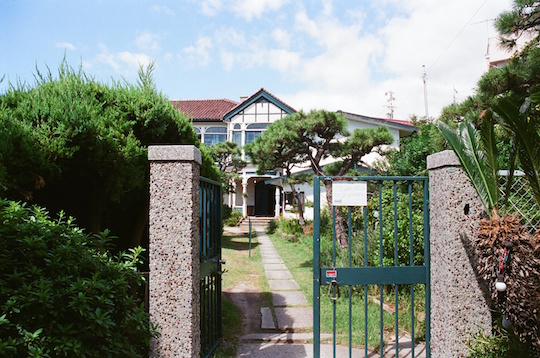
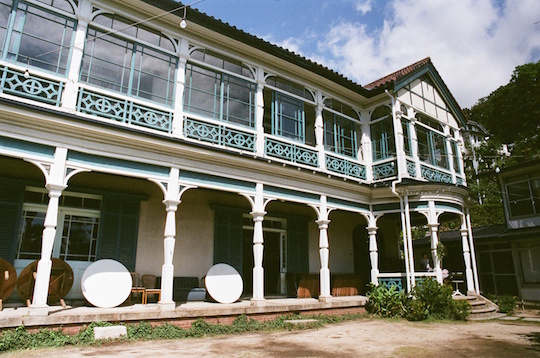 Photo: The name Guggenheim House came from the family of a German trading merchant living in Kobe during the Meiji and Taisho Eras. It was built to Alexander Nelson Hansell’s design in 1909.
Guggenheim House is about to be sold
Photo: The name Guggenheim House came from the family of a German trading merchant living in Kobe during the Meiji and Taisho Eras. It was built to Alexander Nelson Hansell’s design in 1909.
Guggenheim House is about to be sold
Mr. Morimoto worked for his mother, a stained glass artist, for a while after returning to Japan. Then he started to manage Guggenheim House in 2007. Built in 1909 and owned by several families after the Guggenheim family returned to Germany in 1915 due to the war, it came into the hands of a company called Takeuchi Yugyo. The House was used as an employees’ dormitory from the 1960s to the 1970s. After the 1990s, dormitories went out of style due to an increase in studio apartment buildings. Then the company planned to sell the House.
My mother and younger sister were first interested in this building and sent letters, hoping that the empty House could be used in an effective way. Meanwhile, we found that my uncle had a connection with Takeuchi Yugyo and started to have discussions with them. We were planning to raise money to repair the building by hosting an event to show the inside of the House to architects, as well as hosting my sister’s wedding party there.
Around that time, Murotani House, designed by Vories and located in Kobe’s Suma Ward, was demolished after being acquired by a real-estate agent, even though the agent promised to preserve it. This incident concerned his family greatly. Since Mr. Takeuchi also placed priority on making effective use of Guggenheim House, he agreed to sell it to Mr. Morimoto’s parents.
I was opposed to my parents’ decision at first, saying that such a thing should be done by the government. I was, however, interested in serving as a janitor of the row house behind Guggenheim House, because it reminded me of Maison Ikkoku (the eponymous house in a Japanese manga series). For the first year, I worked like a janitor in the apartment, and like a carpenter, repairing the House.
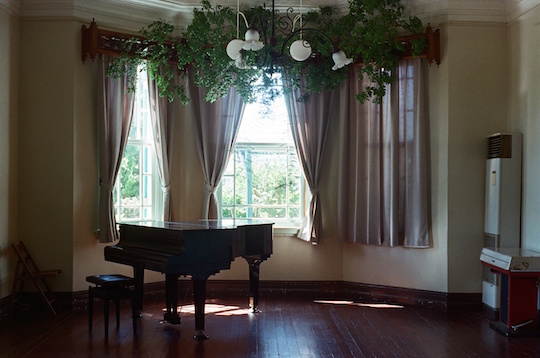 Photo: The hall on the first floor is used to hold concerts and other events. A beautiful garden can be seen from its window.
Photo: The hall on the first floor is used to hold concerts and other events. A beautiful garden can be seen from its window.
 Photo: A lively wedding party held in the garden
Music creates a new flow
Photo: A lively wedding party held in the garden
Music creates a new flow
Once Guggenheim House had become a place for holding music events and wedding parties, the situation suddenly changed, when Ikuko Harada, a member of Clammbon, used the House for recording. Listed among the venues of the band’s tour following their album release in spring of 2008, Guggenheim House became famous at a stroke. Since then, numbers of people wanting to use the site have increased; Mr. Morimoto says it has been booked up continuously for the past three years.
People often ask me what I want to achieve in the future. I am, however, satisfied with the present. When famous musicians, such as Tomoyo Harada and Yukihiro Takahashi, who usually perform at venues for over 1,000 people, held concerts at Guggenheim House, the tickets sold out in minutes. I also hope that the House will serve as a place for musicians to focus on their expression, as well as for the audience to listen to unique music, despite the small scale of such an event.”
Guggenheim House is now fully operational, and is used for culture classes during the daytime, concerts at night, video shooting in the spare time between them, and wedding parties on weekends. At the time, it appeared busy in preparation for Shioya’s cultural festival, to be held in November.
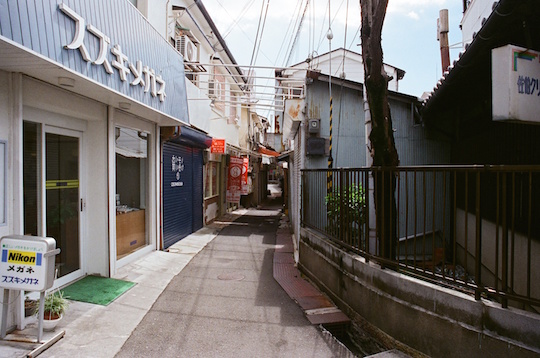
 Photo: People strolling in Shioya
Residents in Shioya change their minds, inspired by Guggenheim House
Photo: People strolling in Shioya
Residents in Shioya change their minds, inspired by Guggenheim House
People enjoy walking along the small streets in Shioya, since there are several nice Western-style residences other than Guggenheim House to admire. In the meantime, Shioya has finally been subjected to an urban development project. The Jonas House, located to the south of Shioya Station, has been demolished to build a condominium, despite a campaign by Mr. Morimoto and others to preserve the building.
I was shocked to hear what older people said, when I participated in a study meeting in preparation for the Shioya Town Development Promotion Association. No one expressed any nostalgia for the town, and I even heard someone saying, “Pull down the shopping street in front of the station, because it just looks like a row of shacks.” Most people seemed completely in favor of the development plan.
To me, developed station squares look boring. Older people, however, see them in a different light. They feel envious of other places that have turned into urbanized towns. Shioya hasn’t been reconstructed, unlike other towns, since it didn’t suffer major damage. Because of this, they have the feeling that Shioya has been left behind by other towns.
He found that many people wanted Shioya to become a town with big roads, a station with a rotary, and high-rise condominiums, as seen elsewhere. Concerned that the Shioya he loved would be rapidly transformed if he did nothing, Mr. Morimoto began to participate in the Shioya Town Development Promotion Association.
Although he faced some difficulties in getting along with people with different values, the situation has changed significantly since Guggenheim House started to move forward. The number of young people in the town has increased as the House has received more media attention. People can walk in the middle of the streets, since few cars drive through Shioya due to its narrow roads. People who visit Shioya are impressed to see that such a place still exists in Kobe. They discover the meaning of the townscapes remaining in Shioya and how important they are. This has helped to further promote Shioya.
Today, residents of Shioya have changed their minds, encouraging the government to set a regulation that restricts the height of buildings to preserve its townscapes. The government has also become more cooperative, changing the scale of the Shioya–Tainohata Road, a 16-meter-wide urban planning road running north-south through Shioya, planned by Kobe City about 70 years ago.
With fewer people and cars, Japan has entered an era where it’s not enough just to keep constructing big, sophisticated buildings. I believe that Japan needs to stay down to earth, and Shioya doesn’t need to change any more. It’s not about new or old—it’s about scale. I don’t think we need buildings with three or more stories in Shioya.
Mr. Morimoto’s words, “we don’t need any more new structures,” and “we don’t need to change,” did not sound pessimistic. Rather, he expressed his beliefs with confidence, looking ahead to the future. When I was walking on a small street in Shioya and listening to music at Guggenheim House, my heart was filled with happiness. Not creating new things, but preserving the things we have that give us happiness now may lead to a brighter future.
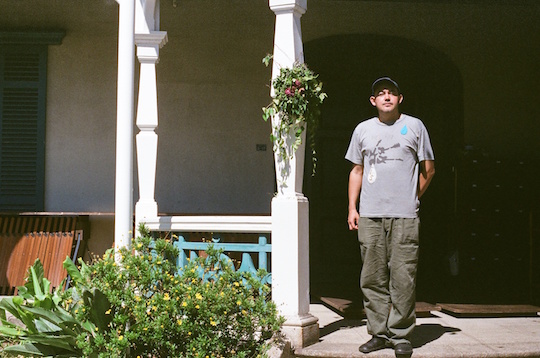
(Interviewed and written by Wataru Yoshida)
This article was created with the cooperation of
greenz.jp.
![]() an artist
an artist JP | EN
JP | EN JP | EN
JP | EN Photo: Ari Morimoto at Guggenheim House
Photo: Ari Morimoto at Guggenheim House


 Photo: The name Guggenheim House came from the family of a German trading merchant living in Kobe during the Meiji and Taisho Eras. It was built to Alexander Nelson Hansell’s design in 1909.
Photo: The name Guggenheim House came from the family of a German trading merchant living in Kobe during the Meiji and Taisho Eras. It was built to Alexander Nelson Hansell’s design in 1909. Photo: The hall on the first floor is used to hold concerts and other events. A beautiful garden can be seen from its window.
Photo: The hall on the first floor is used to hold concerts and other events. A beautiful garden can be seen from its window.  Photo: A lively wedding party held in the garden
Photo: A lively wedding party held in the garden
 Photo: People strolling in Shioya
Photo: People strolling in Shioya 